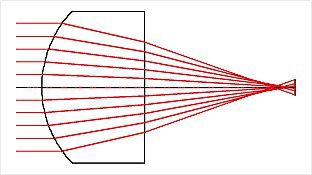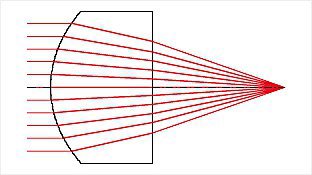
Aspheric lenses are used to reduce the number of lenses in a design, simplify assembly and minimize stray light, eliminate spherical aberration, and improve resolution and system performance. They correct for spherical and off-axis aberrations. A single aspheric lens offers the same amount of spherical aberration correction that two or more spherical lenses can accomplish. Aspheric lenses, by their very nature, are without the spherical aberration that is inherent in traditional plano-convex and double-convex spherical lenses. In addition to spherical aberration correction, aspheric lenses are very powerful in correcting off-axis/ field dependent aberrations such as field curvature, astigmatism, and distortion. Because of this, complicated ten element designs can be reduced to relatively simple four or five element designs.
There are three varieties of aspheric lenses, each with its own benefit. Precision glass molded aspheric lenses are ideal for volume production requirements because of rapid production of many lenses and low tooling upkeep costs; polished aspheric lenses are ideal for prototype or low volume requirements because of short lead time, minimal special tooling and setup; and aspherized hybrid lenses are ideal for multi-spectral applications because of correction for both spherical and chromatic aberrations.

Figure 1: Plano-convex spherical lenses show spherical aberration. Rays from the center focus at a different location than rays exiting from the edges.

Figure 2: A single aspheric lens can correct for spherical aberration vastly reducing the focused spot size.
或查看各区域电话
报价工具
只需输入商品编号
Copyright 2023, 爱特蒙特光学(深圳)有限公司。— 广东省深圳市龙华工业东路利金城科技工业园3栋5楼 518109 - 粤ICP备2021068591号